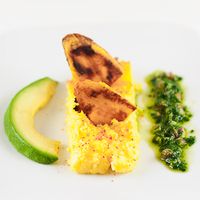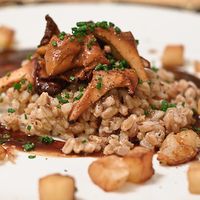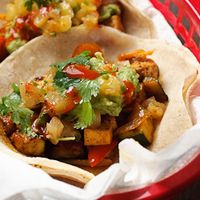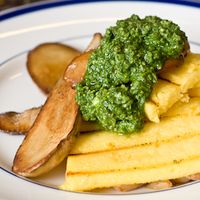How to Plan a Vegetarian Meal by Answering Three Easy Questions
As a vegetarian, one of the things I hear all the time is “I’d like to eat less meat, but I just don’t know how to plan a vegetarian meal.” Without the familiar routine of building a plate with meat at the center, many perfectly competent cooks find themselves at a loss for how to make a dinner that will be truly satisfying.
I’ve been a vegetarian and a serious cook for 25 years, so I’ve planned and prepared several thousand such meals. It may seem like it requires great creativity, but actually the secret couldn’t be simpler. I’ll show you how to do it by answering three easy questions. Better yet, you can start with any of the questions, and it will help inspire and narrow down answers to the others.
- What grain or starch do I feel like eating?
- What food culture am I in the mood for?
- What’s fresh?
Let’s walk through these questions and with each one I’ll share the simple thought processes that lead to a full vegetarian menu. At the end, I’ll point out some pitfalls to avoid.
What grain do I feel like eating?
This might seem like a funny place to start, but actually I find that the grain or starch plays the same anchor role in a vegetarian meal that meat might play otherwise. For example, if I want rice then immediately I’m thinking: risotto, paella, curry, sushi, Mexican food, red beans and rice, … we no longer have a blank sheet of paper. In fact it is an embarrassment of riches! Other grains are more tightly associated with a particular cuisine. If couscous is the foundation, then a Middle Eastern or North African meal is likely to be in the works.
Let’s take a look at a couple of examples. In the first one, the grain (polenta) leads us to the culture (Italian), which in turn leads us to the side dishes. Seasonal fruits and vegetables help us fill in the blank canvas. In the second case, the grain (farro) is paired with seasonal ingredients (chanterelles and apples) in a modern American style, that gives us a rather free hand to choose a simple salad and dessert.
A Meal Based on Polenta
 I’m absolutely mad for polenta, the Italian staple of cornmeal cooked until soft and dosed with a healthy amount of Parmigiano-Reggiano. Polenta is a pretty neutral base that can take many of the same accompaniments as pasta. In this case I was serving it in late fall, when hearty greens like chard are very good (question #3). Keeping with the Italian theme, I chose gorgonzola dolce (a mild blue cheese that willingly yields into the surface of the polenta), and garnished the bowl with a drizzle of top-notch balsamic vinegar.
I’m absolutely mad for polenta, the Italian staple of cornmeal cooked until soft and dosed with a healthy amount of Parmigiano-Reggiano. Polenta is a pretty neutral base that can take many of the same accompaniments as pasta. In this case I was serving it in late fall, when hearty greens like chard are very good (question #3). Keeping with the Italian theme, I chose gorgonzola dolce (a mild blue cheese that willingly yields into the surface of the polenta), and garnished the bowl with a drizzle of top-notch balsamic vinegar.
 For a simple family meal, I would just serve this with a preface of a simple green salad with a tangy dressing or some sauteed green beans with lemon zest. To make it into a dinner party, we could start with vegetarian minestrone or grilled eggplant with a spicy fresh tomato salsa, and serve a crostata for dessert, using whatever fruit is in season – or that we’ve frozen from the summer.
For a simple family meal, I would just serve this with a preface of a simple green salad with a tangy dressing or some sauteed green beans with lemon zest. To make it into a dinner party, we could start with vegetarian minestrone or grilled eggplant with a spicy fresh tomato salsa, and serve a crostata for dessert, using whatever fruit is in season – or that we’ve frozen from the summer.
(Did you know polenta is also popular in Argentina? Here’s a riff on serving it in a South American dish, with chimichurri).
… and Another Based on Farro
 It was a chilly, rainy fall day in Seattle, so a hearty, warming grain like farro suited my mood. If you haven’t worked with farro, you should definitely give it a try – it is healthy, has a nutty flavor and a satisfying but pleasant chew. You can find farro at any natural foods store or upscale market.
It was a chilly, rainy fall day in Seattle, so a hearty, warming grain like farro suited my mood. If you haven’t worked with farro, you should definitely give it a try – it is healthy, has a nutty flavor and a satisfying but pleasant chew. You can find farro at any natural foods store or upscale market.
Apples and chanterelle mushrooms were both in season, answering question #3, and I realized that their natural sweetness when sauteed would complement the grain. I decided to splurge on a generous ration of butter and Calvados (apple brandy) just to make sure the farro wasn’t too healthy.
This dish seems more Pacific Northwest than European. I would probably serve it with a first course of arugula or another peppery green with shards of parmesan, and finish with just some ripe figs for dessert. Well, maybe I’d break out the blowtorch.
What food culture am I in the mood for?
The biggest mistake that Western cooks make when they aim for a meatless meal is to try and convert down-home Americana to be vegetarian. There are some ideas there, but they tend to run out pretty fast or lead to clumsy substitutions for meat. If you look to other countries you’ll find a bounty of choices. Just about every culture in the world has a variety of dishes that are either inherently vegetarian or easily modified.
I don’t know about you, but my cravings are often pretty culturally specific. If I go more than a couple weeks without Thai food, my fingers start to twitch uncontrollably. Sometimes nothing is going to do but a big plate of refried beans and rice with a cheesy enchilada or chili relleno. Or maybe it is an Italian feast that you ardently desire. Wherever it is, odds are there are dishes and flavor combinations just waiting for you.
A Blowout Mexican Feast
For an example, let’s go for a killer Mexican dinner. We’ll actually have two grains here: rice, and corn tortillas. Although tacos are mainly street food in Mexico, they are fantastic for an informal dinner party.
 The formula for great vegetarian tacos is pretty simple: start with a substantial base, like winter squash or grilled tofu, add sauteed vegetables, cheese or crema, and a bright and spicy fresh salsa or slaw. Here are three options: achiote-rubbed butternut squash tacos, roasted potato and asparagus tacos with a kohlrabi slaw, and grilled tofu and bell pepper tacos with grilled pineapple salsa.
The formula for great vegetarian tacos is pretty simple: start with a substantial base, like winter squash or grilled tofu, add sauteed vegetables, cheese or crema, and a bright and spicy fresh salsa or slaw. Here are three options: achiote-rubbed butternut squash tacos, roasted potato and asparagus tacos with a kohlrabi slaw, and grilled tofu and bell pepper tacos with grilled pineapple salsa.
Now let’s go for broke. You obviously don’t have to make all of these dishes, just choose the ones that you have time for: refried beans, green rice or red rice, homemade salsa and ridiculously good guacamole, maybe a quick jicama salad with orange and radish. Take it over the top with a traditional burnt sugar flan.
 Want to make this a whole lot simpler? Skip the tacos, and just serve rice and beans, salsa from a jar, guacamole and grated cheese for a healthy weekday menu.
Want to make this a whole lot simpler? Skip the tacos, and just serve rice and beans, salsa from a jar, guacamole and grated cheese for a healthy weekday menu.
These Swiss chard, onion and Monterey Jack enchiladas would be another fine option instead of the tacos. They are good for a crowd because they finish in the oven, so there is less to fuss with at the last minute. Any or all of the same side dishes would be perfectly welcome.
What’s fresh?
The past few years have seen a tremendous change in our understanding of seasonality and local produce. Most of us know now that asparagus is fresh in the spring, and peaches in the dead of winter are probably going to be… dead.
As you become a more confident cook, you can start by buying the vegetables that look beautiful at the farmer’s market or grocery, knowing that you can turn them into a coherent meal. The huge bonus is that by starting with the freshest, tastiest produce you can lay your hands on, you won’t have to do much to make a delicious meal.
Some vegetables, like eggplant, can go anywhere from India to Italy and back, while others will narrow your focus considerably. Fresh bamboo shoots are probably going to enjoy a visit to China more than, say, New Mexico.
Quinoa Cakes and a Dinner of Homefries
 As an example of cooking based around what is fresh, let me refer you directly to these quinoa cakes, served with a veritable riot of fresh produce from the farmer’s market: caramelized zucchini, corn relish, and a cucumber and tomato salad. That is a whole meal in a bowl.
As an example of cooking based around what is fresh, let me refer you directly to these quinoa cakes, served with a veritable riot of fresh produce from the farmer’s market: caramelized zucchini, corn relish, and a cucumber and tomato salad. That is a whole meal in a bowl.
For an even simpler dinner, what do you do at the end of August when your backyard is full of homegrown potatoes, the tomatoes are at their peak, and a co-worker brings you eggs laid that morning? You make crispy homefries of course, using the potatoes instead of a grain as the starchy base. The cultural frame here is pure Americana.
What can go wrong?
Once you’ve started to master vegetarian dishes from around the world, you can go overboard and start mixing and matching too much. Risotto is great and green curry is great, but if you are going to try and serve them in the same meal, you are risking a grave battle on your palate. I’m not saying fusion menus can never work, but I wouldn’t go there on a first date unless you are quite sure you know what you are doing!
Also, it can be easy to get in a rut. Once you’ve mastered, say, polenta, you can find yourself serving basically the same dish over and over again. The cure is simple: keep using it, but search the web or look through cookbooks to find variations.
 For example, the basic polenta dish above could be made with green beans or eggplant instead of chard, and you could use a young pecorino instead of the gorgonzola. Or polenta can be allowed to cool and then baked or pan-fried and served with tomato sauce. It could be served with a rich ragout of wild mushrooms, topped with a poached egg, or hit with a generous dose of fresh pesto at the peak of basil season. Keep mixing it up and you’ll never grow bored.
For example, the basic polenta dish above could be made with green beans or eggplant instead of chard, and you could use a young pecorino instead of the gorgonzola. Or polenta can be allowed to cool and then baked or pan-fried and served with tomato sauce. It could be served with a rich ragout of wild mushrooms, topped with a poached egg, or hit with a generous dose of fresh pesto at the peak of basil season. Keep mixing it up and you’ll never grow bored.
Summary
Planning vegetarian meals doesn’t have to be any more difficult than meat-centered meals. By following these three simple rules (learn to focus on the grain instead of the meat, look to cultures around the world for ideas, and cook with the best, freshest ingredients you can find), you will discover a universe of options. Take a look around Herbivoracious for more inspiration, and let me know your best vegetarian meal planning tips!

Michael — Hearing your thinking as you plan is a great help, but the other piece I have less intuitive knowledge about is getting enough protein. Do you have a simple way of thinking about that?
Though I’ve been vegan for all of my adult life, I tend to think of veg meals more as a meat eater would, starting with the protein. I feel that a meal based around tofu, tempeh, setian, beans, or lentils (or even a nut-based pesto) are much more satisfying and cohesive than rice and vegetables ever could be.
“…a co-worker brings you eggs laid that morning.” Lucky, lucky. I was offered some home-grown kumquats this morning, but fresh eggs? Still waiting for that to happen. 🙂
Well done, especially with consideration for all cuisines.
Bon appetite!
CCR
=:~)
Wonderful post. I take a very similar approach. Since we get a CSA share, my “what’s fresh” criteria is more based on “what’s in the fridge.”
The main reason I start by choosing the starch is because it usually takes the longest to cook. Kara has a point, but I try to integrate my protein option with the “food culture” choice. Asian dishes are more likely to include tofu, Mexican dishes often have beans, etc.
Great suggestions for brainstorming meal ideas. I think it’s important to emphasize vegetarian sources of protein too. In my experience, many carnivores simply don’t realize this is something they need to consider. As Kara noted above, beans, tofu, etc make a meal much more satisfying – and nutritionally well rounded.
I find the protein issue very strange, I think that culturally some people tend to think much more about proteins than others, and certainly more than me. Some vegetarian beliefs say that you should have protein at every meal, like rice and lentils, pasta and beans and so on.
I react to this the same way as a I react to the person who tells me that he/she cannot function unless they have a stake a day.
Do you really believe that you need plenty of protein every day?
I remembered being told off mostly by vegetarians for my meals than by non vegetarians.
(For example, British vegetarians eating baked beans on toast and telling me that they were having a balanced meal, while my salad wasn’t complete.) But I stuck with my principles based mostly on quality and fresh rather than quantity and nutritional value, and it has been over twenty years now, with small amount of food and even smaller amounts of proteins. I survived.
I learned that I need concentrated proteins (nuts, beans, dairy) in small quantity few times per week, not daily. And proteins are everywhere, not just in tofu, lentils and so on. They are in pasta, in fruit, in vegetables…If your body is healthy it will absorb proteins from most food.
The very important thing to me is, and not just for vegetarians and vegans but for everyone, variety. Variety, variety and more variety!
Teach your body variety and it will respond.
But this is just me :-), maybe someone does need a slice of tempeh a day to survive…
@alessandra Thanks so much for your wisdom! I get weary of “How can you possibly…? I could never survive without my steak a day!” Most people – veggies included – have very little idea about constitutes good nutrition. Tons of protein ain’t it.
I was vegan for a year or so and a doctor expressed horror that I could live without dairy. “Where do you get your calcium?!” (My answer: broccoli) This is a smart, educated MD, with little more knowledge of nutrition than what she learned from TV “Got milk?” ads.
This is great, Michael! It’s motivated me to finally cook the wheat berries I bought at the farmers market a while back! I’m going to brainstorm accompaniments while they soak so if you have any suggestions I’d love to hear them!
Great post! Being a vegetarian, I think planning a meal without meat is easy. What makes it difficult is when your spouse wants meat to make the dinner complete. Then, if you don’t want to make two sep. meats every night, you have to get original and try to make it meatless but satisfying to the meateater. That gets to be challenging. Maybe an idea for your next post 🙂
Hey Allison – your comment brought a smile to my face because wheat berries were focus of one of my worst early experiments in cooking, 25 years ago. I'd tell you what was in that dish but then I'd have to hide under a rock for the rest of my life, it is that embarrassing. I think the key thing is to get the texture right. It really depends how old they are, you need to keep checking to make sure that they are tender but not complete mush. They are extremely hearty and a little will go a long way. My first inclinations would be to either emphasize that heartiness by pairing them with something like cabbage or beet borscht or roasted mushrooms, or to try to lighten them into a salad with a nice vinaigrette and plenty of fresh veg.
@Joanne and anyone else looking to make meals for both veg and omnivores at the same time: run, don't walk, to buy this book: http://bit.ly/44BodX (by Ivy Manning, a friend of mine and expert on that exact subject).
Hi Michael,
I have just realized that this is how I’ve been planning meals since I spent eight years as a vegetarian, starting 20 years ago. Every night I stand in my kitchen and think “pasta, rice or potatoes?” (I guess going for starch, rather than just a grain), and then work in the protein and veggies based on the cuisine I feel like. So interesting to see my thought process spelled out by someone else! Well done.
My own version opf menu-planning is slightly inverted from yours: I start with the cuisine I’m longing for, and then assemble a meal in that style. Last night it was Indian…so I made an okra/tomato curry, and a dal-chicken-other-veggies curry. And some rice to serve them over, because both are a little more liquid than they could be. The balance of ingredients sort of works itself out, I find…but that’s because I’ve been cooking for a while. The temptation to make, say, a squash curry, that okra/tomato curry, and an eggplant curry, and find oneself without any protein or basic starch…that’s bad. But it’s not the route I usually find myself following.
I was interested to see your planning refer to the weather. As I do my week’s menu planning, one of the first things I check is the weather forecast. If Tuesday’s going to be one of those odd summer days where there’s a chilly fog all day, I might make a mediterranean fish stew with aioli rather than the Potage St. Germain. If it’s gonna be stinking hot, gazpacho starts to sound really nice, etc.
@Kathy, @Kara, @Nicole,@Alessandra – I can see the protein question is prominent in people's minds, both in the literal sense of "am I getting enough grams to be healthy?", and in the metaphoric sense of "is it going to be satisfying?". I think these are great questions which deserve their whole own post. Soon. Thanks for your comments!
@Stacy – you are so right about asking "What is in the fridge?" That is a good way to cut back on food waste as well.
@John – Weekly menu planning! I wish I did that. For me it tends to be no more than a day or two in advance, and that ends up limiting how many nights I can cook. Here's to discipline. Although my short-range approach does allow me to fine-tune to the actual weather. I don't think starting with the cuisine/culture is an inversion; although I might not have made it clear enough, I start with any of the three questions probably with equal frequency and see where it leads me with regard to the other two.
this is a great post. if you’re thinking about writing a cookbook, this would make for a nice introductory section.
This is fantastic and extremely helpful. I also found the three step checklist I read about recently in The Kind Diet; plan a meal by choosing (i) a grain, then (ii) a protein; and finally (iii) load up on veggies. This has been a helpful tool for me thus far to planning well rounded vegetarian meals.
Agreed.
Funny, I do the opposite.
1) What’s in the garden (veg drawer)?
2) What flavors (spices, aromatics) flatter #1?
3) What’s the protein?
4) What’s the suitable/handy grain to fill in the corners?
I, an admitted foodie hear a lot of talk about veggies, vegans, pescies etc. I get concerned when I hear youth, especially young girls proudly announce that now they are veggie etc. My concern is that they have little or no information or experience to make that decision and parents seem to go right along. Not only, where are these kids getting their protein, but also where are they getting their iron. Iron (from my little knowledge) is not readily absorbed when derived from not meat sources. Perhaps you could address this subject in the future.
This is very helpful. I always find i have to make time to plan my meals ahead of time. I really liked the recipes that you mentioned above. Thanks
Hi Michael,
thanks for this lovely post. My issue, however, is always sauce. I find that I can usually think of spices to add to a dish, and I understand many of the spices used in my favourite cuisines (Indian, Thai, etc), BUT, my food often comes out dry, and I can never figure out how to correct this! Any advice is helpful.
Without seeing your dishes, it is hard to be sure… but if I had to guess, you either aren’t making enough sauce, or you are cooking too long and it is either getting absorbed or too much liquid is evaporating. You can always add some water or other liquid back to thin out a sauce that has gotten a little too “tight”.